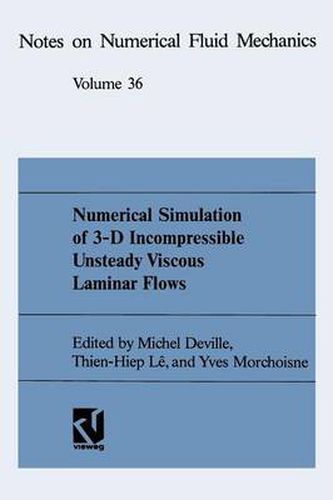Readings Newsletter
Become a Readings Member to make your shopping experience even easier.
Sign in or sign up for free!
You’re not far away from qualifying for FREE standard shipping within Australia
You’ve qualified for FREE standard shipping within Australia
The cart is loading…






This title is printed to order. This book may have been self-published. If so, we cannot guarantee the quality of the content. In the main most books will have gone through the editing process however some may not. We therefore suggest that you be aware of this before ordering this book. If in doubt check either the author or publisher’s details as we are unable to accept any returns unless they are faulty. Please contact us if you have any questions.
The GAMM-Commi ttee for Numerical Methods in Fluid Mechanics (GAMM-Fachausschuss fur Numerische Methoden in der Stromungsmechanik) has sponsored the organization of a GAMM Workshop dedicated to the numerical simulation of three- dimensional incompressible unsteady viscous laminar flows to test Navier-Stokes solvers. The Workshop was held in Paris from June 12th to June 14th, 1991 at the Ecole Nationale Superieure des Arts et Metiers. Two test problems were set up. The first one is the flow in a driven-lid parallelepipedic cavity at Re = 3200 . The second problem is a flow around a prolate spheroid at incidence. These problems are challenging as fully transient solutions are expected to show up. The difficulties for meaningful calculations come from both space and temporal discretizations which have to be sufficiently accurate to resol ve detailed structures like Taylor-Gortler-like vortices and the appropriate time development. Several research teams from academia and industry tackled the tests using different formulations (veloci ty-pressure, vortici ty- velocity), different numerical methods (finite differences, finite volumes, finite elements), various solution algorithms (splitting, coupled, …), various solvers (direct, iterative, semi-iterative) with preconditioners or other numerical speed-up procedures. The results show some scatter and achieve different levels of efficiency. The Workshop was attended by about 25 scientists and drove much interaction between the participants. The contributions in these proceedings are presented in alphabetical order according to the first author, first for the cavi ty problem and then for the prolate spheroid problem. No definite conclusions about benchmark solutions can be drawn.
$9.00 standard shipping within Australia
FREE standard shipping within Australia for orders over $100.00
Express & International shipping calculated at checkout
This title is printed to order. This book may have been self-published. If so, we cannot guarantee the quality of the content. In the main most books will have gone through the editing process however some may not. We therefore suggest that you be aware of this before ordering this book. If in doubt check either the author or publisher’s details as we are unable to accept any returns unless they are faulty. Please contact us if you have any questions.
The GAMM-Commi ttee for Numerical Methods in Fluid Mechanics (GAMM-Fachausschuss fur Numerische Methoden in der Stromungsmechanik) has sponsored the organization of a GAMM Workshop dedicated to the numerical simulation of three- dimensional incompressible unsteady viscous laminar flows to test Navier-Stokes solvers. The Workshop was held in Paris from June 12th to June 14th, 1991 at the Ecole Nationale Superieure des Arts et Metiers. Two test problems were set up. The first one is the flow in a driven-lid parallelepipedic cavity at Re = 3200 . The second problem is a flow around a prolate spheroid at incidence. These problems are challenging as fully transient solutions are expected to show up. The difficulties for meaningful calculations come from both space and temporal discretizations which have to be sufficiently accurate to resol ve detailed structures like Taylor-Gortler-like vortices and the appropriate time development. Several research teams from academia and industry tackled the tests using different formulations (veloci ty-pressure, vortici ty- velocity), different numerical methods (finite differences, finite volumes, finite elements), various solution algorithms (splitting, coupled, …), various solvers (direct, iterative, semi-iterative) with preconditioners or other numerical speed-up procedures. The results show some scatter and achieve different levels of efficiency. The Workshop was attended by about 25 scientists and drove much interaction between the participants. The contributions in these proceedings are presented in alphabetical order according to the first author, first for the cavi ty problem and then for the prolate spheroid problem. No definite conclusions about benchmark solutions can be drawn.